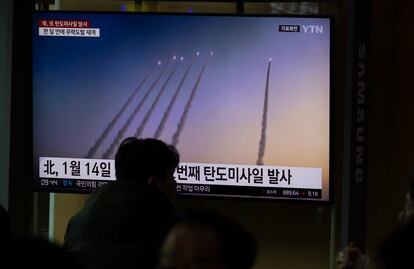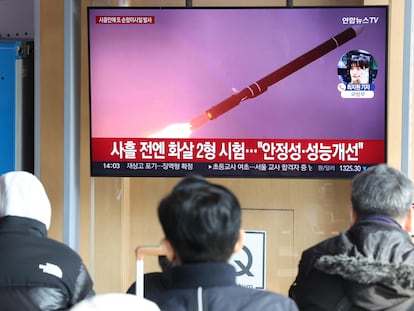North Korea resumes missile tests, raising tensions with its rivals after their military drills’ end
The launches — North Korea’s first known missile testing activities in about a month — came as U.S. Secretary of State Antony Blinken was in Seoul for a democracy summit

North Korea fired multiple short-range ballistic missiles toward its eastern waters Monday morning, its neighbors said, days after the end of the South Korean-U.S. military drills that the North views as an invasion rehearsal.
The launches — North Korea’s first known missile testing activities in about a month — came as U.S. Secretary of State Antony Blinken was in Seoul for a democracy summit. Outside experts earlier predicted North Korea would extend its run of missile tests and intensify its warlike rhetoric ahead of the U.S. presidential election in November to boost its leverage in future diplomacy.
Japan’s Defense Ministry said North Korea fired three missiles, two together at 7:44 a.m. and the other about 37 minutes later. Japanese Prime Minister Fumio Kishida told a parliamentary session that the North Korean missiles landed in the waters between the Korean Peninsula and Japan, all outside of Japan’s exclusive economic zone, and that no damage or injuries have been reported.
Kishida denounced North Korea’s repeated ballistic missile tests as acts “that threaten the peace and safety of Japan, the region and the international society.” He said Japan strongly protested against North Korea over its testing activities, saying they violated U.N. Security Council resolutions that ban the North from engaging in any ballistic activities.
South Korea’s military said it also detected “several” suspected short-range ballistic launches by North Korea on Monday morning. The Joint Chiefs of Staff called the launches “clear provocation” that threaten peace on the Korean Peninsula. It said South Korea will maintain readiness to repel any provocation by North Korea, based on its solid military alliance with the United States.
According to Japanese and South Korean assessments, the North Korean missiles fired from its capital region traveled a distance of 300-350 kilometers (about 185-220 miles) and reached a maximum altitude of 50 kilometers (about 30 miles).Observers say the missiles’ fight distances indicate they are weapons targeting major facilities in South Korea, such as its military headquarters in the central region.
The U.S. State Department condemned the launches, saying they pose a threat to the North’s neighbors and undermine regional security. A State Department statement said the U.S. commitment to the defense of South Korea and Japan remain “ironclad.”
The U.S. stations a total of 80,000 troops in South Korea and Japan, the backbone of its military presence in the Asia-Pacific region.
During the South Korea-U.S. military drills that ended Thursday, North Korean leader Kim Jong Un guided a series of military training exercises involving tanks, artillery guns and paratroopers and called for greater war fighting capabilities. The 11-day South Korean-U.S. drills involved a computer-simulated command post training and 48 kinds of field exercises, twice the number conducted last year.
The North didn’t perform any missile tests during its rivals’ training, however. Its missile tests are considered much bigger provocations as North Korea has been pushing hard to mount nuclear warheads on its missiles targeting the U.S. mainland and its allies. Many experts say North Korea already has nuclear-armed missiles capable of reaching all of South Korea and Japan, but it has yet to have functioning long-range missiles that can strike the U.S. mainland.
Before Monday’s launches, North Korea last carried out missile tests in mid-February by firing cruise missiles into the sea.
Animosities on the Korean Peninsula remain high in the wake of North Korea’s barrage of missile tests since 2022. Many of the tests involved nuclear-capable missiles designed to attack South Korea and the mainland U.S. The U.S. and South Korean forces have responded by expanding their training exercises and trilateral drills involving Japan.
Experts say North Korea likely believes a bigger weapons arsenal would increase its leverage in future diplomacy with the United States. They say North Korea would want to win extensive sanctions relief while maintaining its nuclear weapons.
Worries about North Korean military moves have deepened since Kim vowed in a speech in January to rewrite the constitution to eliminate the country’s long-standing goal of seeking peaceful unification of the Korean Peninsula and to cement South Korea as its “invariable principal enemy.” He said the new charter must specify North Korea would annex and subjugate the South if another war broke out.
Observers say North Korea may launch limited provocations along its tense border with South Korea. But they say the prospects for a full-scale attack by North Korea are dim as it would know its military is outmatched by the U.S. and South Korean forces.
Sign up for our weekly newsletter to get more English-language news coverage from EL PAÍS USA Edition
Tu suscripción se está usando en otro dispositivo
¿Quieres añadir otro usuario a tu suscripción?
Si continúas leyendo en este dispositivo, no se podrá leer en el otro.
FlechaTu suscripción se está usando en otro dispositivo y solo puedes acceder a EL PAÍS desde un dispositivo a la vez.
Si quieres compartir tu cuenta, cambia tu suscripción a la modalidad Premium, así podrás añadir otro usuario. Cada uno accederá con su propia cuenta de email, lo que os permitirá personalizar vuestra experiencia en EL PAÍS.
¿Tienes una suscripción de empresa? Accede aquí para contratar más cuentas.
En el caso de no saber quién está usando tu cuenta, te recomendamos cambiar tu contraseña aquí.
Si decides continuar compartiendo tu cuenta, este mensaje se mostrará en tu dispositivo y en el de la otra persona que está usando tu cuenta de forma indefinida, afectando a tu experiencia de lectura. Puedes consultar aquí los términos y condiciones de la suscripción digital.
More information

North Korea tests more cruise missiles as Kim Jong Un calls for war readiness
Archived In
Últimas noticias
Most viewed
- Oona Chaplin: ‘I told James Cameron that I was living in a treehouse and starting a permaculture project with a friend’
- Sinaloa Cartel war is taking its toll on Los Chapitos
- Reinhard Genzel, Nobel laureate in physics: ‘One-minute videos will never give you the truth’
- Why the price of coffee has skyrocketed: from Brazilian plantations to specialty coffee houses
- Silver prices are going crazy: This is what’s fueling the rally









































